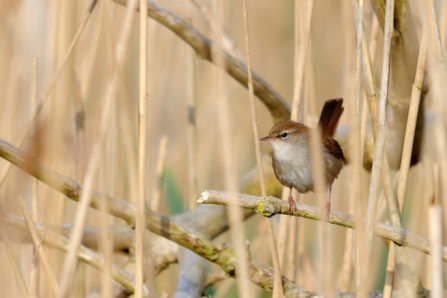
Squirrels on a branch by Roy Macdonald
Cladonia lichen by Philip Precey

Squirrels on a branch by Roy Macdonald
While most humans are huddling inside for warmth, January is peak breeding season for grey squirrels.
Wait long enough in any woodland, park or garden and you might see two or three males chasing a potential mate over benches, fences and up tree trunks.
You can also listen out for their broad repertoire of calls, including chattering, rasping, barking and the female's squeaking mating call.
Make a footprint trap to find out whether squirrels and other animals are visiting your garden:


A well-camouflaged bittern. Photo by Tim Stenton
Bitterns are herons that are well-camouflaged among reeds with their streaky buff and brown plumage.
Winter visitors to our three counties, they’re often easiest to see when they fly over the reeds before descending to hunt for fish.
Look out for bitterns at Weston Turville Reservoir and Calvert Jubilee.

A clump of lichen. Picture: Zsuzsanna Bird
Another great wild highlight to spot while foliage is absent is lichen – a fascinating life form in which a fungus and an alga form a symbiotic partnership.
In the UK there are some 1,800 species of lichen, but some of the most distinctive include oak moss - a ball of turquoise spikes that grows on tree branches; cup lichen, which produces tiny forests of green goblets on stalks, and yellow map lichen, which forms encrusted rosettes up to 15cm across.
Look for lichens in woodlands like our Warburg Nature Reserve near Henley.

Robin and blue tit © Nicholas Watts
The bleak midwinter is the perfect time to feed the birds: with resources scarce, a bird feeder can prove extremely popular with robins, wrens, tits, starlings and blackbirds, as well as winter visitors like waxwings and siskins.
But you don't need to buy a feeder to feed the birds: you can also just throw out cut-up bits of fruit such as apples, pears and raisins, which provide vital hydration.

A common crossbill (Loxia curvirostra). Picture: Stefan Johansson
The common crossbill is a large finch of conifer woodlands, so-named for its cross-tipped bill which it uses to prise out and eat the seeds from pine cones.
It is resident all year round, but some years 'irruptions' occur when it becomes widespread and numerous as it is joined by continental birds looking for food and which may stay to breed.
Bernwood Forest, a few miles east of Oxford, includes coniferous woodland and you can go on a great circular walk from our Bernwood Meadows reserve next door.

Coral spot fungus (Nectria cinnabarina) on a log. Picture: Lairich Rig/ Wikimedia Commons
One of the many fungus species to look out for in the woods at this time of year is coral spot.
Like other fungi, it spends most of its life hidden from view as a web of root-like structures called mycelia.
When coral spot reproduces, it emerges from its host – usually sycamore, horse chestnut or hornbeam - as a rash of bright orange dots, each one a reproductive structure that releases spores.

Wood mouse by Margaret Holland
While you're looking around on the forest floor, you might well spot a vole or mouse.
Indeed, if you sit and wait long enough in any woodland in January you're likely to hear the rustling of leaves as a rodent comes scurrying past in search of food.
Try taking a wander through our Whitecross Green Wood reserve near Bicester or Bowdown Woods in Berkshire.

©Mark Hamblin/2020VISION
A surprising garden visitor that you might see at this time of year is the beautiful sparrowhawk.
This small bird of prey that can be found in all kinds of habitats and often visits gardens looking for its prey - small birds like finches, tits and sparrows.
Males are small with a blue-grey back and white underparts showing reddish-orange barring. Females have browner plumage above and grey bars below. Both have reddish cheeks.

Rookery by David Hawgood
The rook is a large crow that makes a big nest out of twigs in the top of trees, and gathers in large colonies known as 'rookeries'; they often nest in villages and graveyards.
The rook can be distinguished from the similar carrion crow by its pale bill and bare, grey bill-base, and the 'baggy trousers' of feathers around its legs.


Cetti's warbler by Amy Lewis
Cetti’s warbler is another bird that skulks around in scrub close to water. It can be tricky to see but loud bursts of song give away its location.
Once you’ve heard a burst of bubbling song, look for a small-medium sized dark, stocky bird with an upright tail flitting around dense bushes. Wetland reserves like Hosehill Lake are good places to look for these little birds.
Sign up below to receive the latest news from BBOWT, tips about how you can help wildlife, plus information on how you can get involved.